Impact of Canadian Policies on Indigenous Women's Mental Health
VerifiedAdded on 2022/08/13
|7
|1968
|19
Essay
AI Summary
This essay examines the mental health challenges faced by Indigenous women in Canada, arguing that despite governmental interventions, these women continue to be affected by mental health issues. The discussion covers the impact of historical policies, such as the Doctrine of Assimilation, which led to cultural loss, separation of children through residential schools, and intergenerational trauma. The essay highlights the role of violence, substance abuse, and the Canadian justice system in exacerbating these issues. It also addresses the effects of forced sterilization and social disparities on Indigenous women's mental health. The author concludes that despite various policies, Indigenous women remain a marginalized group facing significant mental health struggles, emphasizing the need for further support and solutions to address these complex challenges.
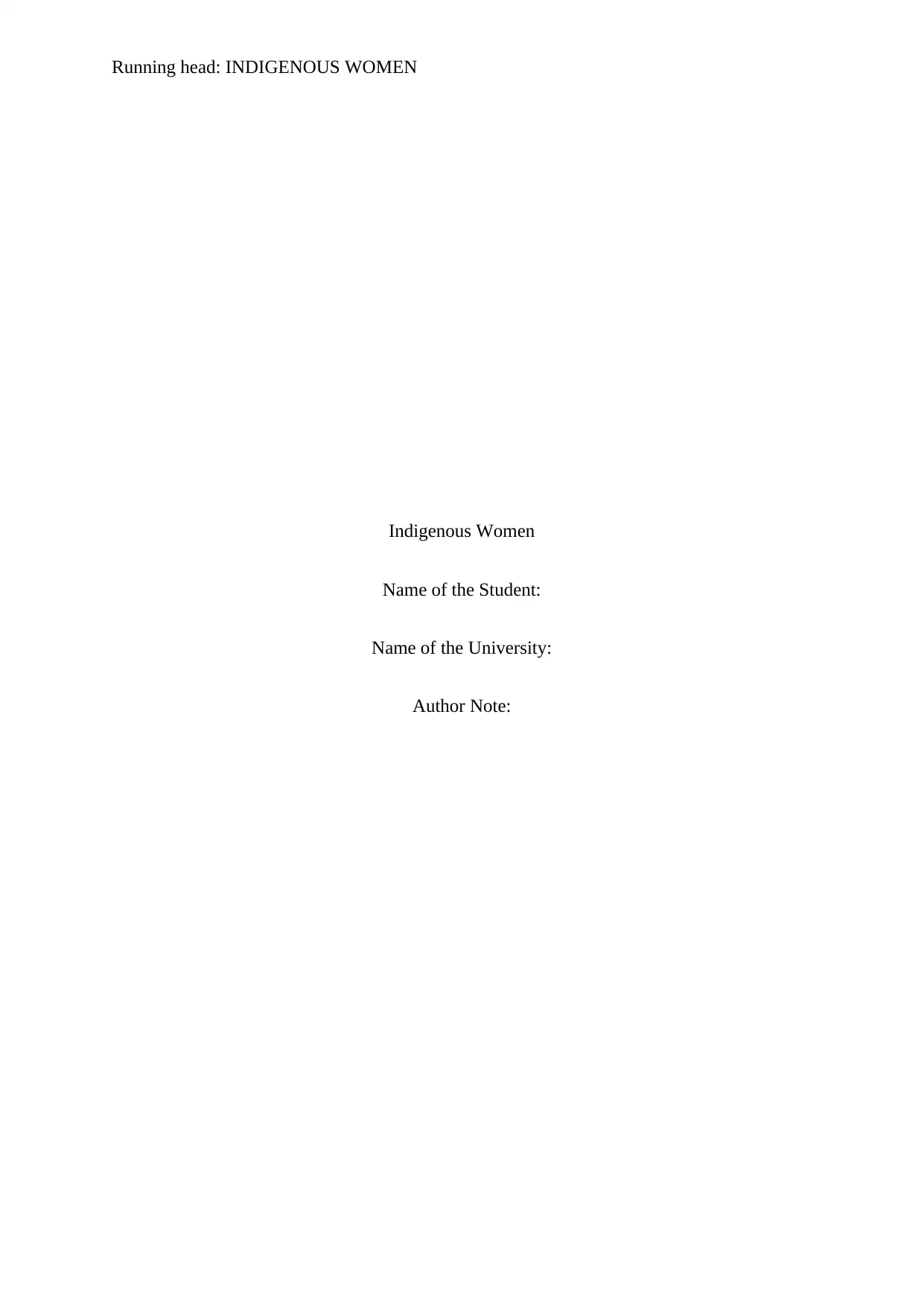
Running head: INDIGENOUS WOMEN
Indigenous Women
Name of the Student:
Name of the University:
Author Note:
Indigenous Women
Name of the Student:
Name of the University:
Author Note:
Paraphrase This Document
Need a fresh take? Get an instant paraphrase of this document with our AI Paraphraser
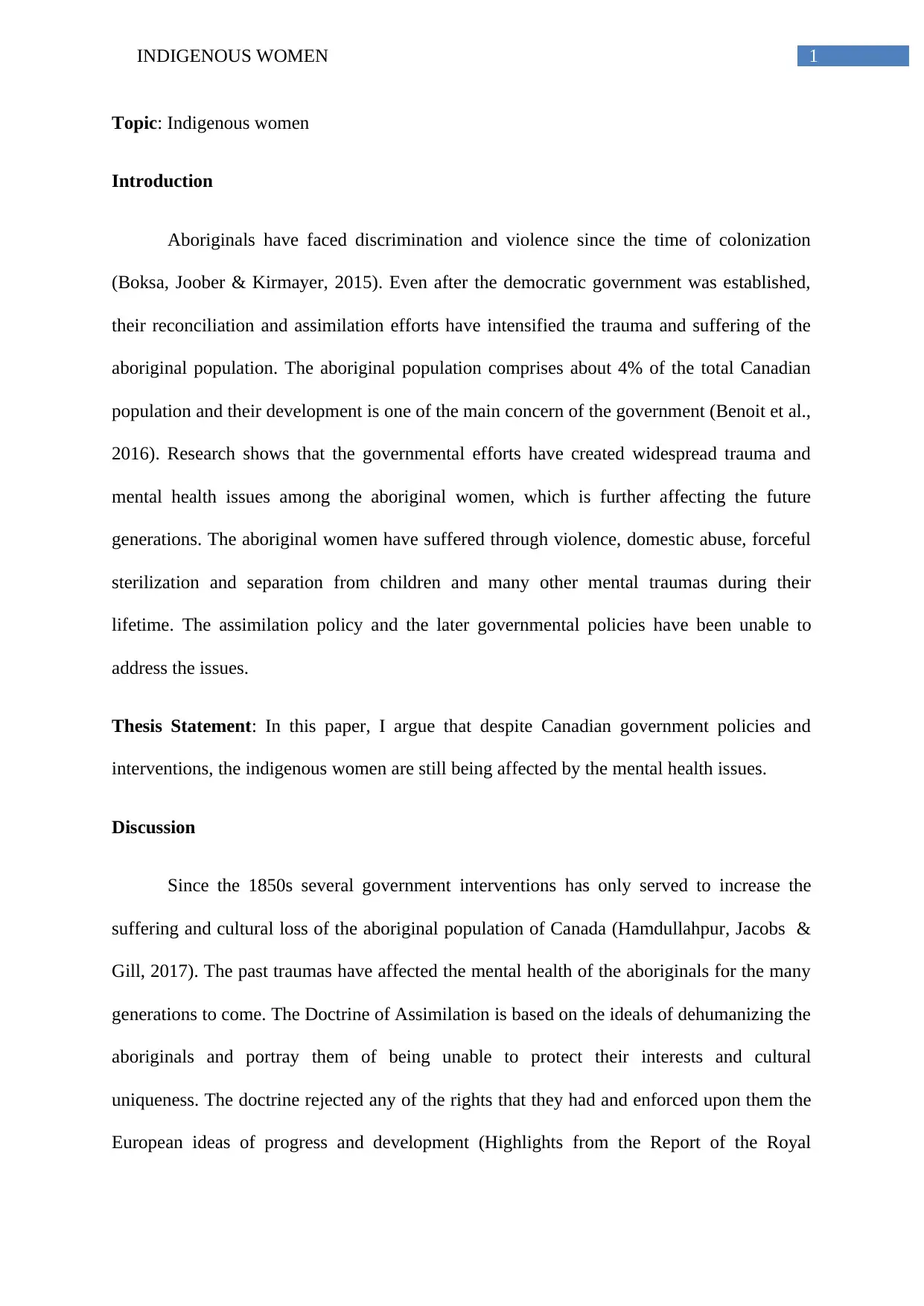
1INDIGENOUS WOMEN
Topic: Indigenous women
Introduction
Aboriginals have faced discrimination and violence since the time of colonization
(Boksa, Joober & Kirmayer, 2015). Even after the democratic government was established,
their reconciliation and assimilation efforts have intensified the trauma and suffering of the
aboriginal population. The aboriginal population comprises about 4% of the total Canadian
population and their development is one of the main concern of the government (Benoit et al.,
2016). Research shows that the governmental efforts have created widespread trauma and
mental health issues among the aboriginal women, which is further affecting the future
generations. The aboriginal women have suffered through violence, domestic abuse, forceful
sterilization and separation from children and many other mental traumas during their
lifetime. The assimilation policy and the later governmental policies have been unable to
address the issues.
Thesis Statement: In this paper, I argue that despite Canadian government policies and
interventions, the indigenous women are still being affected by the mental health issues.
Discussion
Since the 1850s several government interventions has only served to increase the
suffering and cultural loss of the aboriginal population of Canada (Hamdullahpur, Jacobs &
Gill, 2017). The past traumas have affected the mental health of the aboriginals for the many
generations to come. The Doctrine of Assimilation is based on the ideals of dehumanizing the
aboriginals and portray them of being unable to protect their interests and cultural
uniqueness. The doctrine rejected any of the rights that they had and enforced upon them the
European ideas of progress and development (Highlights from the Report of the Royal
Topic: Indigenous women
Introduction
Aboriginals have faced discrimination and violence since the time of colonization
(Boksa, Joober & Kirmayer, 2015). Even after the democratic government was established,
their reconciliation and assimilation efforts have intensified the trauma and suffering of the
aboriginal population. The aboriginal population comprises about 4% of the total Canadian
population and their development is one of the main concern of the government (Benoit et al.,
2016). Research shows that the governmental efforts have created widespread trauma and
mental health issues among the aboriginal women, which is further affecting the future
generations. The aboriginal women have suffered through violence, domestic abuse, forceful
sterilization and separation from children and many other mental traumas during their
lifetime. The assimilation policy and the later governmental policies have been unable to
address the issues.
Thesis Statement: In this paper, I argue that despite Canadian government policies and
interventions, the indigenous women are still being affected by the mental health issues.
Discussion
Since the 1850s several government interventions has only served to increase the
suffering and cultural loss of the aboriginal population of Canada (Hamdullahpur, Jacobs &
Gill, 2017). The past traumas have affected the mental health of the aboriginals for the many
generations to come. The Doctrine of Assimilation is based on the ideals of dehumanizing the
aboriginals and portray them of being unable to protect their interests and cultural
uniqueness. The doctrine rejected any of the rights that they had and enforced upon them the
European ideas of progress and development (Highlights from the Report of the Royal
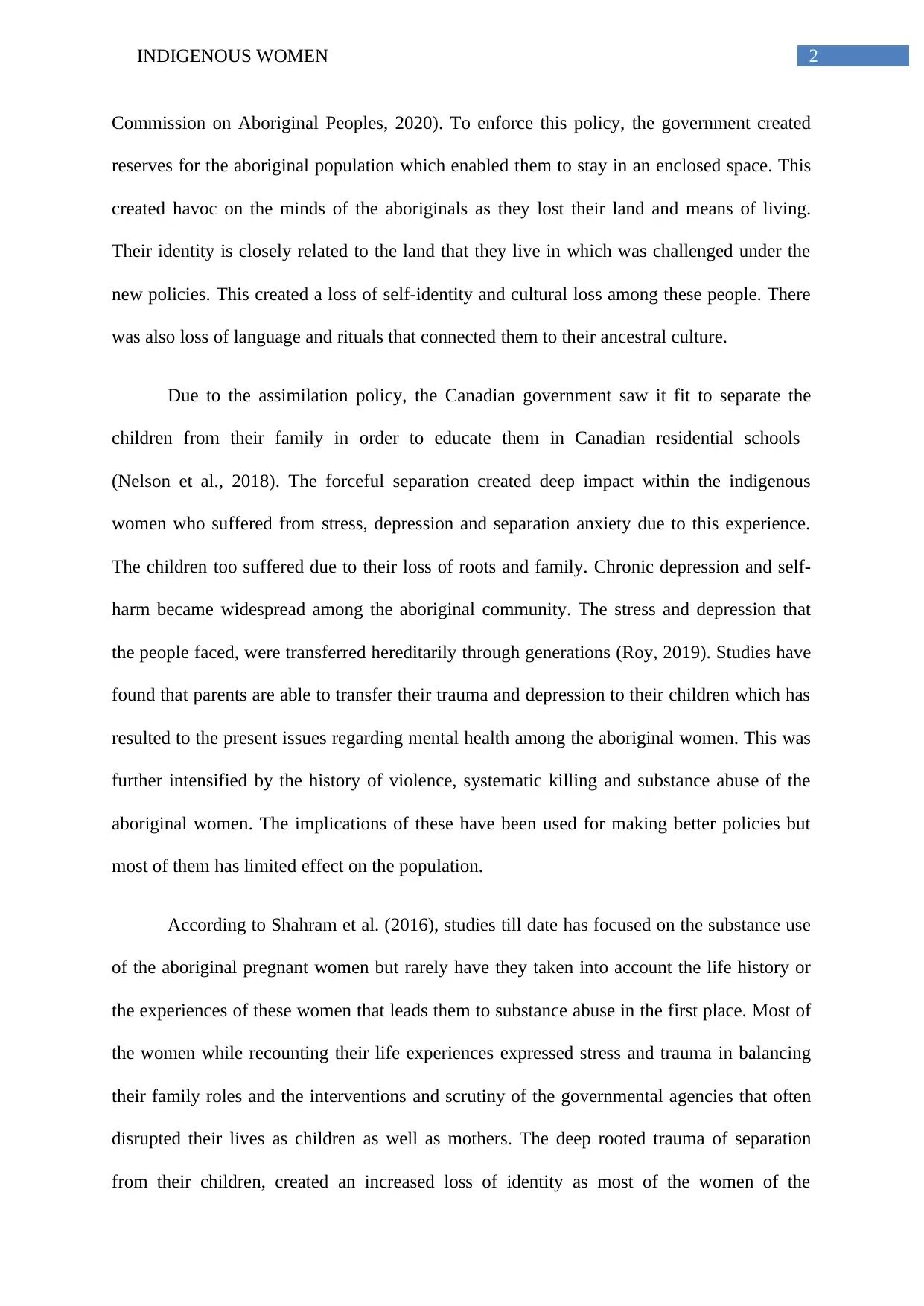
2INDIGENOUS WOMEN
Commission on Aboriginal Peoples, 2020). To enforce this policy, the government created
reserves for the aboriginal population which enabled them to stay in an enclosed space. This
created havoc on the minds of the aboriginals as they lost their land and means of living.
Their identity is closely related to the land that they live in which was challenged under the
new policies. This created a loss of self-identity and cultural loss among these people. There
was also loss of language and rituals that connected them to their ancestral culture.
Due to the assimilation policy, the Canadian government saw it fit to separate the
children from their family in order to educate them in Canadian residential schools
(Nelson et al., 2018). The forceful separation created deep impact within the indigenous
women who suffered from stress, depression and separation anxiety due to this experience.
The children too suffered due to their loss of roots and family. Chronic depression and self-
harm became widespread among the aboriginal community. The stress and depression that
the people faced, were transferred hereditarily through generations (Roy, 2019). Studies have
found that parents are able to transfer their trauma and depression to their children which has
resulted to the present issues regarding mental health among the aboriginal women. This was
further intensified by the history of violence, systematic killing and substance abuse of the
aboriginal women. The implications of these have been used for making better policies but
most of them has limited effect on the population.
According to Shahram et al. (2016), studies till date has focused on the substance use
of the aboriginal pregnant women but rarely have they taken into account the life history or
the experiences of these women that leads them to substance abuse in the first place. Most of
the women while recounting their life experiences expressed stress and trauma in balancing
their family roles and the interventions and scrutiny of the governmental agencies that often
disrupted their lives as children as well as mothers. The deep rooted trauma of separation
from their children, created an increased loss of identity as most of the women of the
Commission on Aboriginal Peoples, 2020). To enforce this policy, the government created
reserves for the aboriginal population which enabled them to stay in an enclosed space. This
created havoc on the minds of the aboriginals as they lost their land and means of living.
Their identity is closely related to the land that they live in which was challenged under the
new policies. This created a loss of self-identity and cultural loss among these people. There
was also loss of language and rituals that connected them to their ancestral culture.
Due to the assimilation policy, the Canadian government saw it fit to separate the
children from their family in order to educate them in Canadian residential schools
(Nelson et al., 2018). The forceful separation created deep impact within the indigenous
women who suffered from stress, depression and separation anxiety due to this experience.
The children too suffered due to their loss of roots and family. Chronic depression and self-
harm became widespread among the aboriginal community. The stress and depression that
the people faced, were transferred hereditarily through generations (Roy, 2019). Studies have
found that parents are able to transfer their trauma and depression to their children which has
resulted to the present issues regarding mental health among the aboriginal women. This was
further intensified by the history of violence, systematic killing and substance abuse of the
aboriginal women. The implications of these have been used for making better policies but
most of them has limited effect on the population.
According to Shahram et al. (2016), studies till date has focused on the substance use
of the aboriginal pregnant women but rarely have they taken into account the life history or
the experiences of these women that leads them to substance abuse in the first place. Most of
the women while recounting their life experiences expressed stress and trauma in balancing
their family roles and the interventions and scrutiny of the governmental agencies that often
disrupted their lives as children as well as mothers. The deep rooted trauma of separation
from their children, created an increased loss of identity as most of the women of the
⊘ This is a preview!⊘
Do you want full access?
Subscribe today to unlock all pages.

Trusted by 1+ million students worldwide
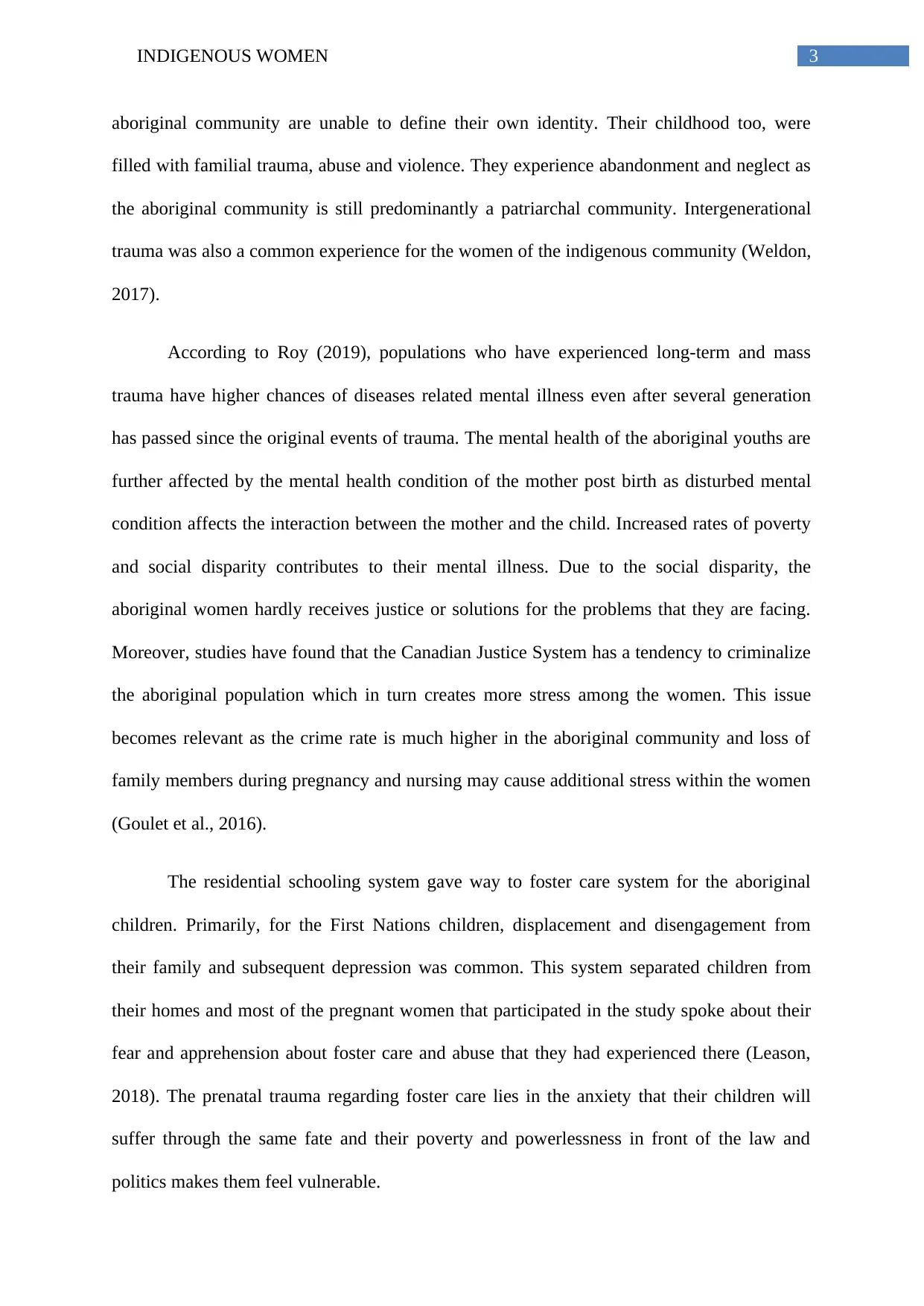
3INDIGENOUS WOMEN
aboriginal community are unable to define their own identity. Their childhood too, were
filled with familial trauma, abuse and violence. They experience abandonment and neglect as
the aboriginal community is still predominantly a patriarchal community. Intergenerational
trauma was also a common experience for the women of the indigenous community (Weldon,
2017).
According to Roy (2019), populations who have experienced long-term and mass
trauma have higher chances of diseases related mental illness even after several generation
has passed since the original events of trauma. The mental health of the aboriginal youths are
further affected by the mental health condition of the mother post birth as disturbed mental
condition affects the interaction between the mother and the child. Increased rates of poverty
and social disparity contributes to their mental illness. Due to the social disparity, the
aboriginal women hardly receives justice or solutions for the problems that they are facing.
Moreover, studies have found that the Canadian Justice System has a tendency to criminalize
the aboriginal population which in turn creates more stress among the women. This issue
becomes relevant as the crime rate is much higher in the aboriginal community and loss of
family members during pregnancy and nursing may cause additional stress within the women
(Goulet et al., 2016).
The residential schooling system gave way to foster care system for the aboriginal
children. Primarily, for the First Nations children, displacement and disengagement from
their family and subsequent depression was common. This system separated children from
their homes and most of the pregnant women that participated in the study spoke about their
fear and apprehension about foster care and abuse that they had experienced there (Leason,
2018). The prenatal trauma regarding foster care lies in the anxiety that their children will
suffer through the same fate and their poverty and powerlessness in front of the law and
politics makes them feel vulnerable.
aboriginal community are unable to define their own identity. Their childhood too, were
filled with familial trauma, abuse and violence. They experience abandonment and neglect as
the aboriginal community is still predominantly a patriarchal community. Intergenerational
trauma was also a common experience for the women of the indigenous community (Weldon,
2017).
According to Roy (2019), populations who have experienced long-term and mass
trauma have higher chances of diseases related mental illness even after several generation
has passed since the original events of trauma. The mental health of the aboriginal youths are
further affected by the mental health condition of the mother post birth as disturbed mental
condition affects the interaction between the mother and the child. Increased rates of poverty
and social disparity contributes to their mental illness. Due to the social disparity, the
aboriginal women hardly receives justice or solutions for the problems that they are facing.
Moreover, studies have found that the Canadian Justice System has a tendency to criminalize
the aboriginal population which in turn creates more stress among the women. This issue
becomes relevant as the crime rate is much higher in the aboriginal community and loss of
family members during pregnancy and nursing may cause additional stress within the women
(Goulet et al., 2016).
The residential schooling system gave way to foster care system for the aboriginal
children. Primarily, for the First Nations children, displacement and disengagement from
their family and subsequent depression was common. This system separated children from
their homes and most of the pregnant women that participated in the study spoke about their
fear and apprehension about foster care and abuse that they had experienced there (Leason,
2018). The prenatal trauma regarding foster care lies in the anxiety that their children will
suffer through the same fate and their poverty and powerlessness in front of the law and
politics makes them feel vulnerable.
Paraphrase This Document
Need a fresh take? Get an instant paraphrase of this document with our AI Paraphraser
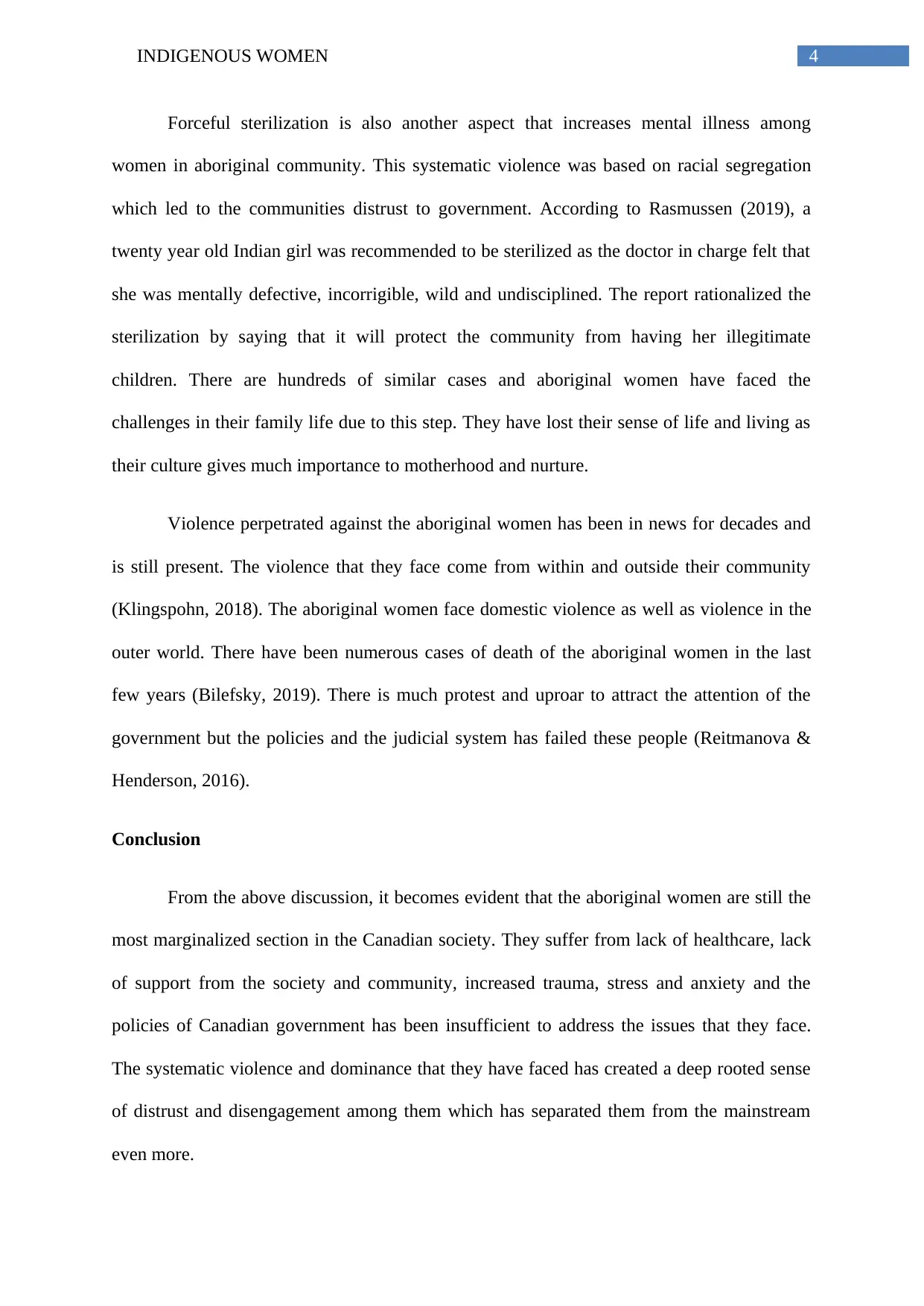
4INDIGENOUS WOMEN
Forceful sterilization is also another aspect that increases mental illness among
women in aboriginal community. This systematic violence was based on racial segregation
which led to the communities distrust to government. According to Rasmussen (2019), a
twenty year old Indian girl was recommended to be sterilized as the doctor in charge felt that
she was mentally defective, incorrigible, wild and undisciplined. The report rationalized the
sterilization by saying that it will protect the community from having her illegitimate
children. There are hundreds of similar cases and aboriginal women have faced the
challenges in their family life due to this step. They have lost their sense of life and living as
their culture gives much importance to motherhood and nurture.
Violence perpetrated against the aboriginal women has been in news for decades and
is still present. The violence that they face come from within and outside their community
(Klingspohn, 2018). The aboriginal women face domestic violence as well as violence in the
outer world. There have been numerous cases of death of the aboriginal women in the last
few years (Bilefsky, 2019). There is much protest and uproar to attract the attention of the
government but the policies and the judicial system has failed these people (Reitmanova &
Henderson, 2016).
Conclusion
From the above discussion, it becomes evident that the aboriginal women are still the
most marginalized section in the Canadian society. They suffer from lack of healthcare, lack
of support from the society and community, increased trauma, stress and anxiety and the
policies of Canadian government has been insufficient to address the issues that they face.
The systematic violence and dominance that they have faced has created a deep rooted sense
of distrust and disengagement among them which has separated them from the mainstream
even more.
Forceful sterilization is also another aspect that increases mental illness among
women in aboriginal community. This systematic violence was based on racial segregation
which led to the communities distrust to government. According to Rasmussen (2019), a
twenty year old Indian girl was recommended to be sterilized as the doctor in charge felt that
she was mentally defective, incorrigible, wild and undisciplined. The report rationalized the
sterilization by saying that it will protect the community from having her illegitimate
children. There are hundreds of similar cases and aboriginal women have faced the
challenges in their family life due to this step. They have lost their sense of life and living as
their culture gives much importance to motherhood and nurture.
Violence perpetrated against the aboriginal women has been in news for decades and
is still present. The violence that they face come from within and outside their community
(Klingspohn, 2018). The aboriginal women face domestic violence as well as violence in the
outer world. There have been numerous cases of death of the aboriginal women in the last
few years (Bilefsky, 2019). There is much protest and uproar to attract the attention of the
government but the policies and the judicial system has failed these people (Reitmanova &
Henderson, 2016).
Conclusion
From the above discussion, it becomes evident that the aboriginal women are still the
most marginalized section in the Canadian society. They suffer from lack of healthcare, lack
of support from the society and community, increased trauma, stress and anxiety and the
policies of Canadian government has been insufficient to address the issues that they face.
The systematic violence and dominance that they have faced has created a deep rooted sense
of distrust and disengagement among them which has separated them from the mainstream
even more.
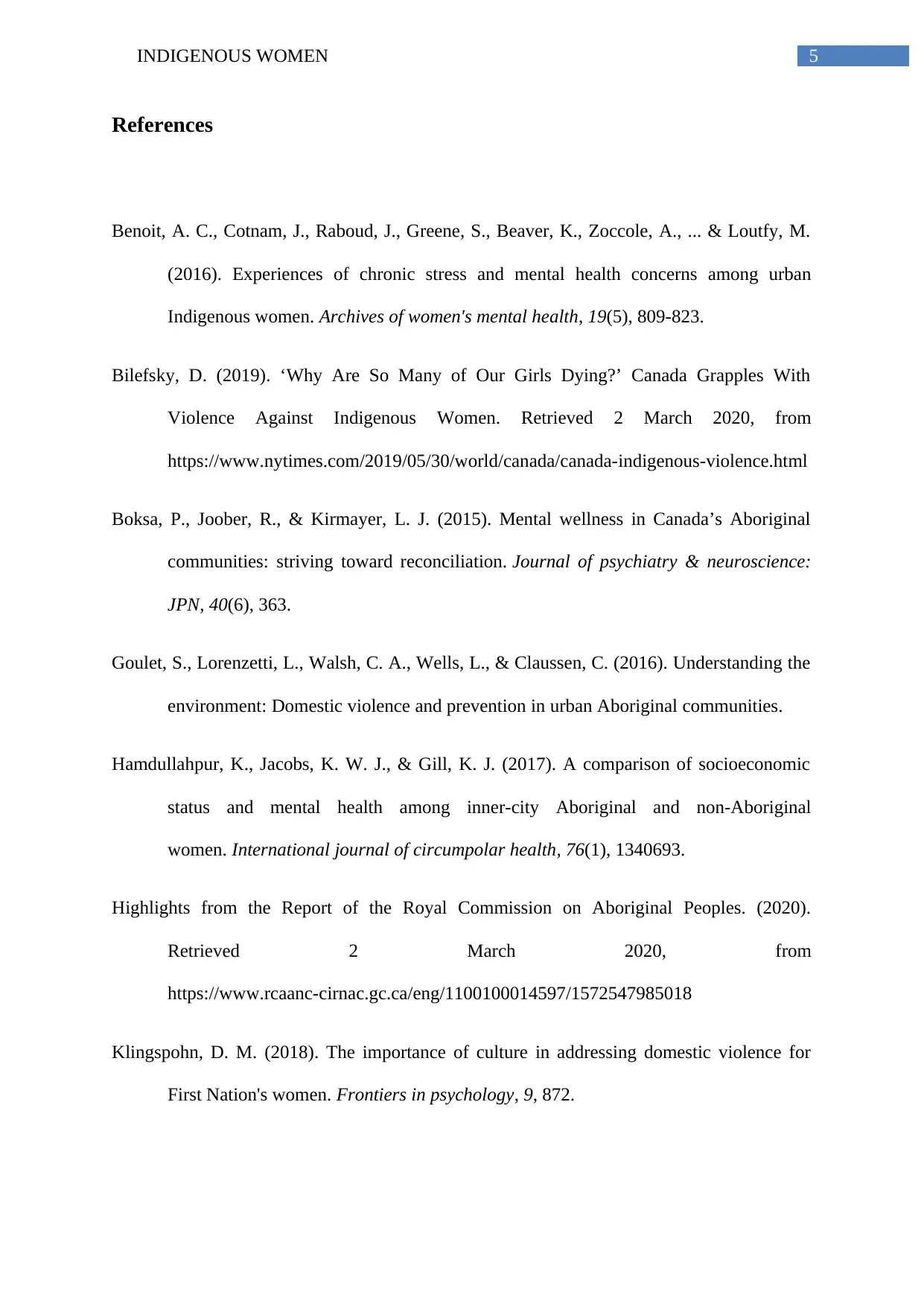
5INDIGENOUS WOMEN
References
Benoit, A. C., Cotnam, J., Raboud, J., Greene, S., Beaver, K., Zoccole, A., ... & Loutfy, M.
(2016). Experiences of chronic stress and mental health concerns among urban
Indigenous women. Archives of women's mental health, 19(5), 809-823.
Bilefsky, D. (2019). ‘Why Are So Many of Our Girls Dying?’ Canada Grapples With
Violence Against Indigenous Women. Retrieved 2 March 2020, from
https://www.nytimes.com/2019/05/30/world/canada/canada-indigenous-violence.html
Boksa, P., Joober, R., & Kirmayer, L. J. (2015). Mental wellness in Canada’s Aboriginal
communities: striving toward reconciliation. Journal of psychiatry & neuroscience:
JPN, 40(6), 363.
Goulet, S., Lorenzetti, L., Walsh, C. A., Wells, L., & Claussen, C. (2016). Understanding the
environment: Domestic violence and prevention in urban Aboriginal communities.
Hamdullahpur, K., Jacobs, K. W. J., & Gill, K. J. (2017). A comparison of socioeconomic
status and mental health among inner-city Aboriginal and non-Aboriginal
women. International journal of circumpolar health, 76(1), 1340693.
Highlights from the Report of the Royal Commission on Aboriginal Peoples. (2020).
Retrieved 2 March 2020, from
https://www.rcaanc-cirnac.gc.ca/eng/1100100014597/1572547985018
Klingspohn, D. M. (2018). The importance of culture in addressing domestic violence for
First Nation's women. Frontiers in psychology, 9, 872.
References
Benoit, A. C., Cotnam, J., Raboud, J., Greene, S., Beaver, K., Zoccole, A., ... & Loutfy, M.
(2016). Experiences of chronic stress and mental health concerns among urban
Indigenous women. Archives of women's mental health, 19(5), 809-823.
Bilefsky, D. (2019). ‘Why Are So Many of Our Girls Dying?’ Canada Grapples With
Violence Against Indigenous Women. Retrieved 2 March 2020, from
https://www.nytimes.com/2019/05/30/world/canada/canada-indigenous-violence.html
Boksa, P., Joober, R., & Kirmayer, L. J. (2015). Mental wellness in Canada’s Aboriginal
communities: striving toward reconciliation. Journal of psychiatry & neuroscience:
JPN, 40(6), 363.
Goulet, S., Lorenzetti, L., Walsh, C. A., Wells, L., & Claussen, C. (2016). Understanding the
environment: Domestic violence and prevention in urban Aboriginal communities.
Hamdullahpur, K., Jacobs, K. W. J., & Gill, K. J. (2017). A comparison of socioeconomic
status and mental health among inner-city Aboriginal and non-Aboriginal
women. International journal of circumpolar health, 76(1), 1340693.
Highlights from the Report of the Royal Commission on Aboriginal Peoples. (2020).
Retrieved 2 March 2020, from
https://www.rcaanc-cirnac.gc.ca/eng/1100100014597/1572547985018
Klingspohn, D. M. (2018). The importance of culture in addressing domestic violence for
First Nation's women. Frontiers in psychology, 9, 872.
⊘ This is a preview!⊘
Do you want full access?
Subscribe today to unlock all pages.

Trusted by 1+ million students worldwide
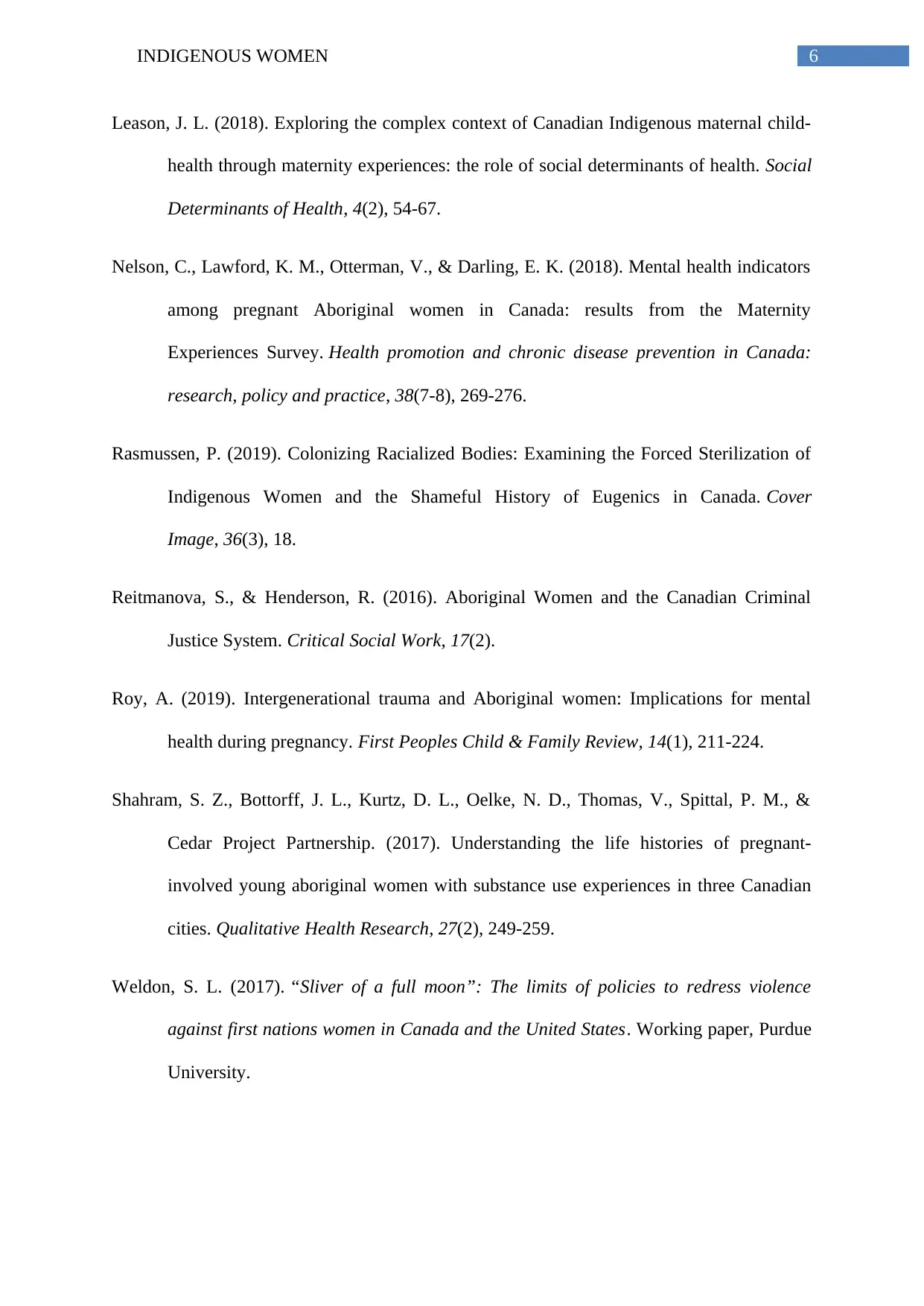
6INDIGENOUS WOMEN
Leason, J. L. (2018). Exploring the complex context of Canadian Indigenous maternal child-
health through maternity experiences: the role of social determinants of health. Social
Determinants of Health, 4(2), 54-67.
Nelson, C., Lawford, K. M., Otterman, V., & Darling, E. K. (2018). Mental health indicators
among pregnant Aboriginal women in Canada: results from the Maternity
Experiences Survey. Health promotion and chronic disease prevention in Canada:
research, policy and practice, 38(7-8), 269-276.
Rasmussen, P. (2019). Colonizing Racialized Bodies: Examining the Forced Sterilization of
Indigenous Women and the Shameful History of Eugenics in Canada. Cover
Image, 36(3), 18.
Reitmanova, S., & Henderson, R. (2016). Aboriginal Women and the Canadian Criminal
Justice System. Critical Social Work, 17(2).
Roy, A. (2019). Intergenerational trauma and Aboriginal women: Implications for mental
health during pregnancy. First Peoples Child & Family Review, 14(1), 211-224.
Shahram, S. Z., Bottorff, J. L., Kurtz, D. L., Oelke, N. D., Thomas, V., Spittal, P. M., &
Cedar Project Partnership. (2017). Understanding the life histories of pregnant-
involved young aboriginal women with substance use experiences in three Canadian
cities. Qualitative Health Research, 27(2), 249-259.
Weldon, S. L. (2017). “Sliver of a full moon”: The limits of policies to redress violence
against first nations women in Canada and the United States. Working paper, Purdue
University.
Leason, J. L. (2018). Exploring the complex context of Canadian Indigenous maternal child-
health through maternity experiences: the role of social determinants of health. Social
Determinants of Health, 4(2), 54-67.
Nelson, C., Lawford, K. M., Otterman, V., & Darling, E. K. (2018). Mental health indicators
among pregnant Aboriginal women in Canada: results from the Maternity
Experiences Survey. Health promotion and chronic disease prevention in Canada:
research, policy and practice, 38(7-8), 269-276.
Rasmussen, P. (2019). Colonizing Racialized Bodies: Examining the Forced Sterilization of
Indigenous Women and the Shameful History of Eugenics in Canada. Cover
Image, 36(3), 18.
Reitmanova, S., & Henderson, R. (2016). Aboriginal Women and the Canadian Criminal
Justice System. Critical Social Work, 17(2).
Roy, A. (2019). Intergenerational trauma and Aboriginal women: Implications for mental
health during pregnancy. First Peoples Child & Family Review, 14(1), 211-224.
Shahram, S. Z., Bottorff, J. L., Kurtz, D. L., Oelke, N. D., Thomas, V., Spittal, P. M., &
Cedar Project Partnership. (2017). Understanding the life histories of pregnant-
involved young aboriginal women with substance use experiences in three Canadian
cities. Qualitative Health Research, 27(2), 249-259.
Weldon, S. L. (2017). “Sliver of a full moon”: The limits of policies to redress violence
against first nations women in Canada and the United States. Working paper, Purdue
University.
1 out of 7
Related Documents
Your All-in-One AI-Powered Toolkit for Academic Success.
+13062052269
info@desklib.com
Available 24*7 on WhatsApp / Email
![[object Object]](/_next/static/media/star-bottom.7253800d.svg)
Unlock your academic potential
Copyright © 2020–2025 A2Z Services. All Rights Reserved. Developed and managed by ZUCOL.





